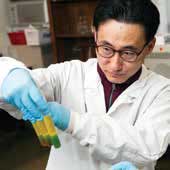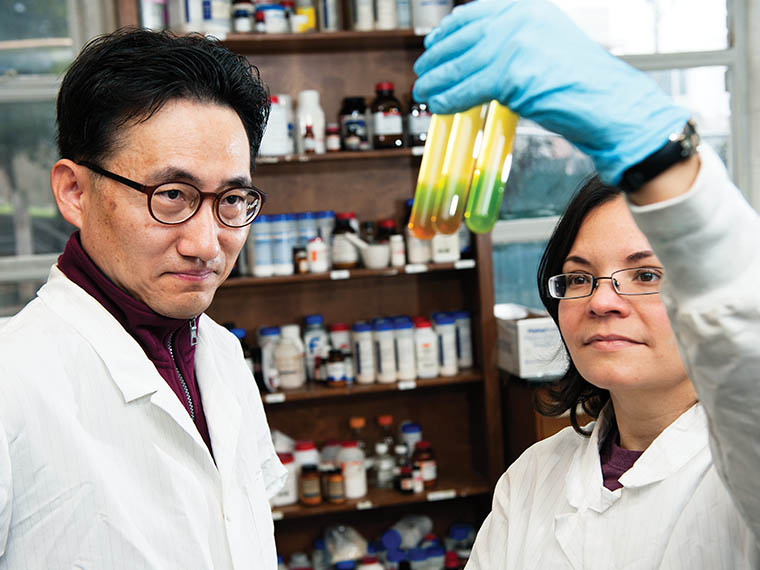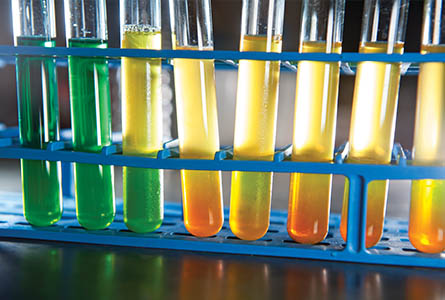Front line of food safety
Rapidly detecting foodborne pathogens
By: Vanessa Beeson
The information presented on this page may be dated. It may refer to situations which have changed or people who are no longer affiliated with the university. It is archived as part of Mississippi State University's history.
According to the Centers for Disease Control and Prevention, foodborne pathogens cause an estimated 47.8 million illnesses, 128,000 hospitalizations and 3,000 deaths in the U.S. each year.
"Early detection at the field and processing plant level can prevent cross-contamination of foodborne pathogens," said Taejo Kim, assistant research professor in the Mississippi Agricultural and Forestry Experiment Station's Department of Food Science, Nutrition and Health Promotion.
Kim has discovered a way to make industry-wide testing of certain foodborne pathogens fast, easy and affordable.
Kim invented one-tube pathogen assay kits for Salmonella, Listeria, E.coli O157:H7 and three strains of Vibrio. Salmonella, Listeria and E.coli can be found in all types of foods. Vibrio bacteria found in seawater, can contaminate seafood.
"The kits are easy, rapid, reliable and cost-effective," said Kim. "They require no analytic instruments, results are available in 24 hours or less, reliability has a very high sensitivity and specificity and the kits are inexpensive to produce."
Current rapid methods available for isolating and detecting the pathogens that cause foodborne illnesses use molecular tools such as real-time PCR. This requires extracting DNA and loading a test kit into an analytic system that is very costly. Each individual test kit costs $10. The process requires considerable labor and skill. Technicians must know how to extract DNA from food matrix. Conventional methods can take up to five days to obtain the results.
Kim said the rapid kits culture, separate and detect whole target pathogen cells in a single tube as opposed to DNA or antigen detection so it is easier to use than any other commercial kit.
"It takes an hour to train a technician on how to use the kits," Kim said.
Within 24 hours, the results indicate whether or not a pathogen is present. From there, researchers can use multiple tubes to enumerate the pathogen.
"While the current technology can indicate whether or not a pathogen is present, it doesn't tell you how much of the pathogen is there," Kim said. "Our kit can be utilized to determine how much of the pathogen is present."
"Provisional patents have been filed for the methods, procedures and ingredients for single tube Salmonella, Listeria and E.coli kits.
"I am working on domestic and international utility patents for the Salmonella, Listeria and E.coli kits," Kim said.
The Vibrio kits, also submitted for patent, were invented under a collaborative research agreement between MSU and the Food and Drug Administration's Gulf Coast Seafood Laboratory in Dauphin Island, Alabama.
"FDA provided data on various clinical and non-clinical strains of Vibrio parahaemolyticus for me to analyze. I was able to isolate the unique biomarker for Vibrio," Kim said. "This collaboration led us to a discovery that would have taken years had that data not been available for analysis."
Kim said his mission is to continue to develop rapid and cost-effective assay kits to assist the industry and consumers in improving food safety, quality and marketability.
"For food safety, we introduce rapid and easy-to-use pathogen assay kits and utilize them as tools for rapid end-product on-site testing including environmental samples," Kim said. "For food quality, we develop and validate novel food processing and good sanitation programs on fresh and frozen food to expand industry capacity and marketability."
While Kim has been at MSU for the last two decades and considers Mississippi his home, he recently visited South Korea, his native country, and found inspiration there.
"South Korea is a very industrialized nation and the country's adoption of robotics made me realize that automation is the next step in this research," Kim said. "I believe this is world-class technology for foodborne pathogens and the next generation of this technology will be field-applicable robots equipped with kits."
Behind the Science

Taejo Kim
Assistant Research Professor
Education: B.S., Food Engineering, College of Engineering, Daegu University (South Korea); M.S.; Ph.D., Food Science and Technology, Mississippi State University
Years At MSU: 19
Focus: Food safety and molecular detection of foodborne pathogens and food processing
Passion At Work: I enjoy reading big data of biochemical/molecular analysis on microorganisms. Reading the data correctly helps reduce experimental/validation errors.


